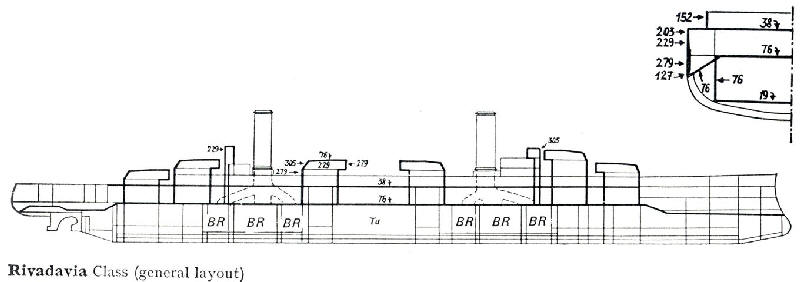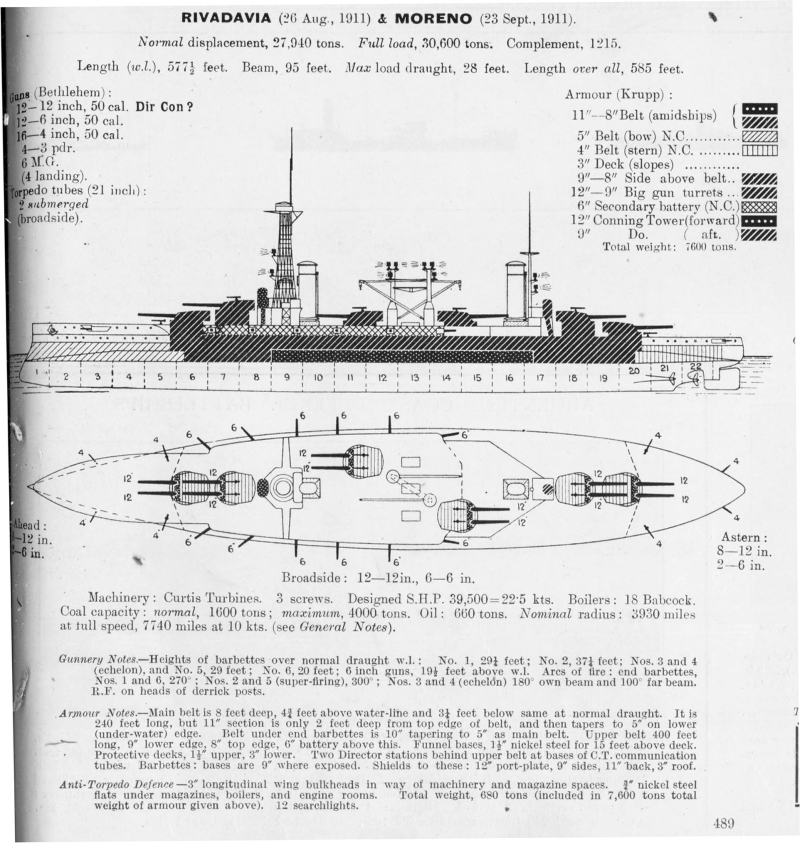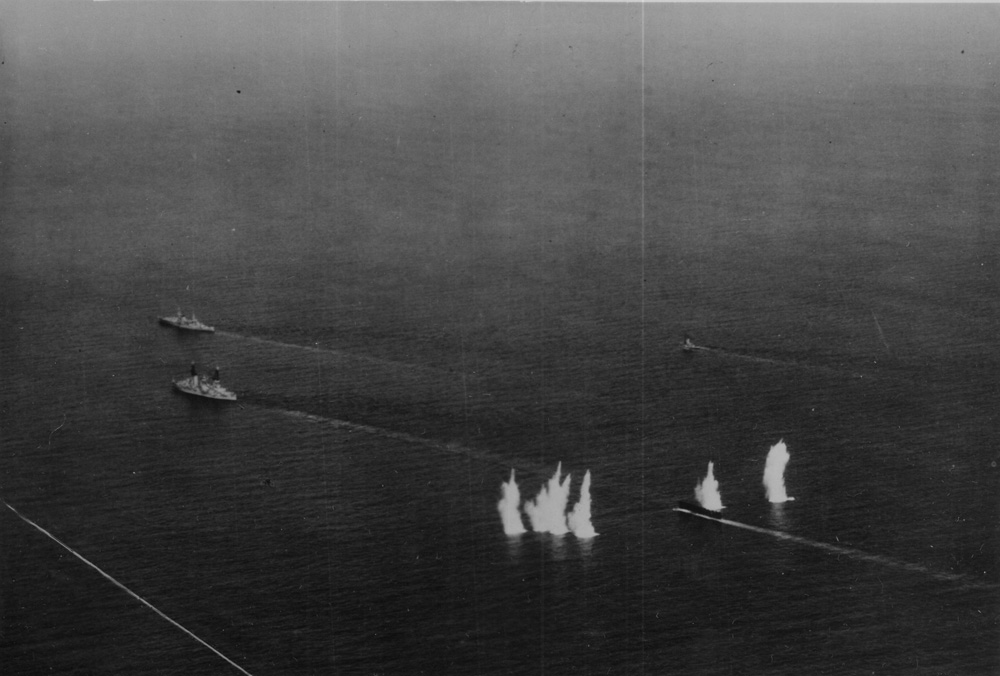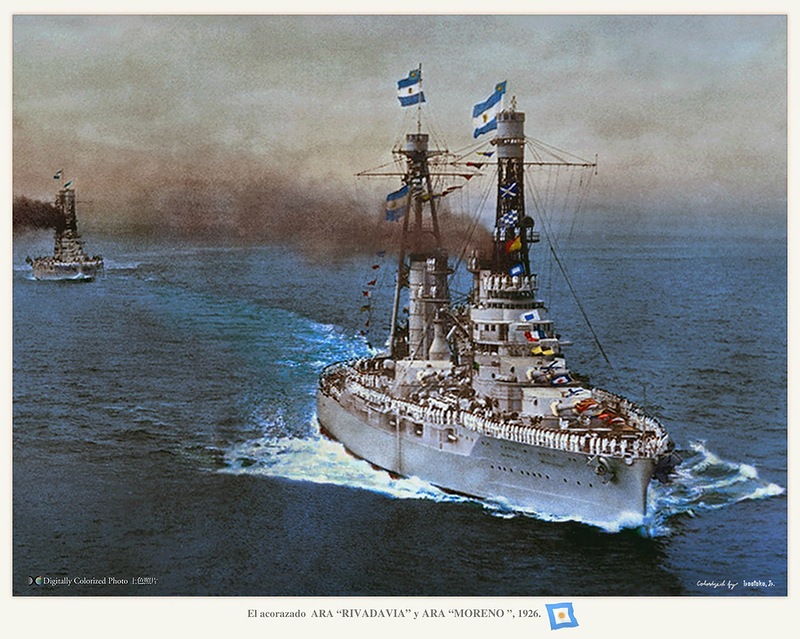- yes! as part of the USA researchable tech tree! complete the trio of 6.7 BR Dreadnoughts!
- yes! but as a Squadron Researchable in the US naval forces! 6.7 BR Dreadnought trio! but in a different way!
- yes! as part of a future Pan-South American tree! one glorious hodgepodge!
- yes! as an event rare! ships like these are what events are made for!
- yes! as a Battle Pass reward! ships like these are what these BP Seasons exist for!
- No!
Launched in 1911,
Commissioned in 1914,
heavily refitted from 1924-1926,
sporadically refitted for more and better AA armament at various times throughout the next 10 years
Decommissioned in 1952,
scrapped in 1957.
lifespan: 47 years.
ARA Rivadavia on initial sea trials off the US East Coast
 (https://upload.wikimedia.org/wikipedia/commons/thumb/4/40/Rivadavia_Battleship_LOC_14781u.jpg/1024px-Rivadavia_Battleship_LOC_14781u.jpg)
(https://upload.wikimedia.org/wikipedia/commons/thumb/4/40/Rivadavia_Battleship_LOC_14781u.jpg/1024px-Rivadavia_Battleship_LOC_14781u.jpg)
This video from Drachinifel is about all 3 classes of battleship from the South American Dreadnought Race, which of course includes the Rivadavia-class. well worth watching just for the note of sister ship ARA Moreno’s homicidal desire to mow down barges and run aground.
ORIGIN:
The Rivadavia-class came as the result of low intensity border conflicts due to competing territorial claims between Argentina with Brazil to the northeast, and with Chile to the west, with a series of cold wars continuing throughout the unstable late 1800s and early 1900s.
Needless to say, the state of multiple ongoing cold wars… like the one Argentina and Chile ended in 1902… in South America made for a rather tense environment when anyone made any big plays… like for example, when Brazil started to modernize its outdated and outgunned navy (that 20 years prior was nearly the best in both American continents) and add a few pre-dreadnought battleships in order to just about totally reequip its then-obsolete navy in 1904. This plan then got one hell of an upgrade when these pre-dreadnought hulls were aborted and broken up for a reworked contract request of 2 of the brand new type of battleship design introduced with; and named after; HMS Dreadnought hit the scene in 1906; later amended to include a plus a follow-up third ship; resulting in the Minas Geraes-class, a 1st Generation Dreadnought design for a South American republic before most major European empires had their own.
Argentina did not like this. suspenseful music
Despite only being a couple years into a British-brokered detente with the Chileans, Argentina knew that if it ever went to war with Brazil, a trio of state of the art dreadnought battleships would make quick work of them, and so answered with an order for an even bigger battleship right around the time when the 2nd generation of Dreadnought designs was at its height right before the Orion-class Superdreadnought showed that way forwards.
Funnily enough, the Rivadavia-class being entirely ordered as an answer to the Minas Geraes-class quite literally makes the Rivadavia-class a Super(comma)Dreadnought compared to the Minas Geraes-class, which Chile then answered with the Almirante Latorre-class of actually Superdreadnought, in a series of events that became known as the South American Dreadnought Race, one of the strangest and most ludicrous nationstate d**k measuring contests prior to the Great War, encapsulated within a semi-continental Cold War.
BIDDING AND CONSTRUCTION:
for a detailed readout on how fascinating just the bidding process was to see who’d build the Argentine battleships, look at Rivadavia-class battleship - Wikipedia. that whole situation was insane.
the bidding TL;DR version:
Ultimately, when all was said and all shenanigans were done, construction contracts were awarded to US shipbuilder Fore River in early 1910, completely shocking the Europeans- who by the way were each so remarkably pissed off that there’s an entire section on the Rivadavia wiki dedicated to the international reaction alone! but it’s likely at least partly due to the American Steel Trust’s ability to produce steel at a lower cost than any other country, seemingly undercutting the Anglo-Italo-German bidding war from out of nowhere.
Rivadavia-class battleship - Wikipedia,
Foreign practices also bore a large influence on the design; most were acquired through the unique design process of rejecting multiple bids and calling for the best aspects (read: national pseudo-trade secrets) of each:
A superfiring arrangement of the main battery was an American innovation…
|
the asymmetric offset en echelon wing turrets were a (arguably net negative) feature of British 1st generation Dreadnought designs…
|
The secondary battery of 6-inch guns and the three-propshaft system were influenced by German design practices…
|
And the engine and boiler layout were reminiscent of the Italian dreadnought Dante Alighieri.
|
Shortly after Rivadavia had completed its trials, the U.S. Navy’s Board of Inspection and Survey remarked that the ship “handled remarkably well… with comparatively minor modifications the vessel would practically meet the requirements of our own vessels.” The USN Board of Inspection however was less pleased with the en echelon wing turrets, stating that “while theoretically the Rivadavia has an ahead and astern fire of six guns, this is not so in reality, as it is almost certain that the blast from the waist turrets would dish in the smokepipes and damage the uptakes.”
|
note to self- in battleship construction class, bully the English exchange student with his stupid and fancy ideas, befriend the American nerd with his good ideas and monopolistic connections to US Steel.
|
so despite the layout of the heavy guns (as seen below), the Rivadavia and Moreno would still have to pivot a little to be able to safely fire one of the wing turrets in support of the superfiring turrets at the aft or bow, and despite being able to traverse that far, you couldn’t fire a wing turret guns across the deck in the same direction as the opposite wing turret without doing serious self-harm…
…not that that would ever stop us in WT from doing exactly that. repeatedly… so technically Rivadavia has a 12-gun broadside!
SERVICE HISTORY:
As opposed to the bidding process, the actual service life of the ARA Rivadavia and sister ship ARA Moreno were rather uneventful and diplomatic in nature, even when compared to the floating rebellions of the Minas Geraes-class and especially the grizzled WWI Veteran Almirante Latorre-class ships.
The ships finally arrived in Argentina in February and May 1915, respectively.
One of the very last Dreadnought-style battleships built, the Rivadavia-class are I think only passed in commissioning by the España-class Dreadnoughts of Spain.
After commissioning, there were then persistent…and partly true… rumors abound that the Argentine government was now looking to SELL the Rivadavia and Moreno.
While the original 1908 government makeup was in favor of acquiring and maintaining battleships despite the difficulties of doing such, the more socialist-influenced post-1914 government made multiple attempts to pass bills to put the Rivadavia and Moreno up for sale (which being at the start of WWI would’ve been guaranteed to sell), all of which failed- both for internal politics reasons, and externally because the US government was REALLY not comfortable with its now-state of the art-ish design being sold out to potential rivals in the other major powers like its perennial trans-pacific rival Japan or enemy-to-be Germany, and there was a condition in the contract with Fore River where the US was effectively the only nation that could legally purchase Rivadavia and Moreno unless the US waived it.
So by the time that political support for selling Rivadavia and Moreno had finally reached its threshold, the Rivadavia and Moreno were outdated, with dreadnoughts and superdreadnoughts now being equally obsolete compared to newer interwar-era battleship that finally dropped the Dreadnought moniker. …and there was no way that Argentina could recoup the costs.
So with that unfortunate issue in mind, In the early 1920s both ships spent time in the reserve fleet due to an economic depression. Eventually enough money was available by 1924 to have the duo modernized in the United States. Both refits included a conversion from coal and fuel oil, to fuel oil-only firing, a new fire-control system, and a funnel cap so as to not cause smoke interference with the rangefinders.
“the fire controls were modernized and new directions of fire were installed on the B and E towers. The main and secondary batteries were not altered, but 4 of the 16 102 mm guns. They were replaced by 4 76 mm (actually 40mm) anti-aircraft pieces. The aftmast was replaced with another tripod, the searchlights were changed, and rudders, shaft and propellers were carefully inspected. The displacement rose to 31,000 tons. The external appearance of the pair did not change much, except for the details of the aft mast and the firing directors on the turrets, and they were still clearly first-generation battleships.”
In the 1930s they mainly participated in training cruises and diplomatic trips.
|
|
in an interesting aside note: sister ship ARA Moreno additionally participated in the same voyage as the 1937 Coronation of King George VI Naval Review at Spithead, where New York Times’ reporter Hanson Baldwin described it as “a strange vestigial sea monster in this company of more modern fighting ships”… which is something of an ironic statement to make as Moreno was itself only 2-6 years older than most of the other 20+ years old active service battleships on earth, such as all of the USN Standard Type battleships at that point, due to the battleship holiday stemming from the 1922 Washington Naval Treaty.
|
|
The Rivadavia-class’s 1939 training cruise to Brazil with naval cadets embarked just before the beginning of the Second World War in September, and destroyers had to be sent from Argentina to escort them home as a matter of safety.
During the war, both Rivadavia and Moreno were largely inactive due to Argentine neutrality.
Rivadavia undertook a last diplomatic cruise to Trinidad, Venezuela, and Colombia in 1946, and both ships were immobile by 1948.
Rivadavia was stricken on February 1st, 1957, and scrapped in Italy beginning in 1959.
The money gained from selling the two dreadnoughts along with an older armored cruiser, ARA Pueyrredón, was used to buy the aircraft carrier HMS Warrior from the UK, which was then renamed ARA Independencia… the Brits regretted that 30 years later.
GENERAL CHARACTERISTICS:
Displacement:
27,500 long tons (27,900 t) standard,
30,100 long tons (30,600 t) full load
31,600 long tons full load, after 1926 refits.
|
Length:
594 ft 9 in (181.28 m) overall,
585 ft (178 m) between perpendiculars
|
Beam:
98 ft 4.5 in (29.985 m)
|
Draft:
27 ft 8.5 in (8.446 m)
|
|
Propulsion:
18 Babcock & Wilcox coal-burning boilers outfitted with fuel oil sprays, feeding into 3 sets of Curtis geared steam turbines, producing ~40,000 shaft horsepower (29,828 kW), going down 3 shafts to 3 propellers, producing speeds of 22.567 knots (25.970 mph; 41.794 km/h).
post-1926:
boilers were converted to oil fuel only, bumping horsepower up to 47,300.
as the class was now powered by fuel oil only, its roughly 40,000 horsepower was bumped up to 47,300 horsepower. this upped the speed accordingly: the original 22.567 knots (25.970 mph; 41.794 km/h) was after refits, 23.2 knots (43 km/h, 26.7 mph).
|
|
fuel: 4000 tons of coal, 600 tons of fuel oil
|
|
Crew: 1000 enlisted crew, 130 officers
MODEL VIEW:
this is an interesting thing I found. remarkably well detailed models of Rivadavia and Moreno in a museum in the town of Tigre, north of Buenos Aires, with the pictures dated 2003. if you aren’t just skimming through it very highly recommend looking through them.
http://www.histarmar.com.ar/Armada Argentina/Buques1900a1970/AcARARivadavia-Moreno-Modelos.htm
http://www.histarmar.com.ar/Armada Argentina/MuseoNaval/Fotos2/83acor.jpg
ARMOR:
armor values are aggregated from multiple sources, so there may be contradictions
Armored Belt: 305mm across most of the citadel, covering the machinery spaces
The belt was 305mm at its thickest amidships, raised 5 feet (1.5 m) above the waterline, and 6 feet (1.8 m) below, with a decreasing thickness down to 127mm to the prow and finally 102mm at the stern.
Main belt was 2.4m in height and covered all hull length, only a little not reaching stern frame.
Armor plates reached 254mm thickness abreast barbettes of end turrets and 280mm between them; further in a bow and a stern the belt had 127mm and 102mm thickness respectively.
Over the main belt there was a 229-203mm (9-8 inch) Upper Belt.
Longitudinal bulkhead: 76mm
Underwater protection consisted of 76mm longitudinal bulkhead, dipped from main armour deck break to a double bottom and placed in 2.5m from a side.
on these ships for the first time in the world an attempt to defend the machinery and magazines from explosion under the bottom was undertaken: decks (more precisely platforms) of these compartments were protected by 19mm armor.
after 1925/26 refit, the now redundant coal storage bunkers were used as buffer spaces, AKA basic anti-shrapnel spaced armor
Main Gun Turrets armor:
12-inch (305mm) front
9-inch (229mm) sides
11-inch (279mm) back
3-inch (76mm) roofs
|
Main Gun Barbettes:
11-inch (279mm)
|
Casemates:
6-inch (152mm)
|
Conning Tower/Citadel:
|
Fronts: 12-inch (305mm)
sides / roof: 9-inch (229mm)
Back: 3-inch (76mm)
|
Decks ranged from: 1.5 to 3-inches (38-76mm)
Upper deck and secondary armament on it: 1.5-inches.
Battery/Upper deck between end barbettes had 38mm thickness.
Horizontal main deck: 51mm (2-inch). increases to 76mm (3-inch) on angles, joining the belt once vertical
Main 76mm deck placed at level of an upper edge of the main belt. reaching about 2.5m to a side, at 45° angle was dipped downwards and adjoined lower edge of the belt. In a bow and stern from end turrets main deck was dipped on one level lower and became flat.
Deck armor was .5 in (13 mm) medium steel plates, and 2 in (51 mm) on the upper level, in Harvey nickel steel.
ARMAMENT:
(1914-1924)
4×2 305mm Marca L Modelo 1 guns, mounted in centerline & superfiring positions
2x2 305mm Marca L Modelo 1 guns, mounted en echelon in offset wing positions
12"/50 Bethlehem
fun fact, the Bethlehem guns were a unique; if still extremely similar; modification to the 12"/50 Mk. 7 Mod. 0 guns used on ships like the Wyoming-class dreadnought battleships seen ingame… and were used nowhere else.
EDIT: as explained by COLDOWN, the 305mm Marca L Modelo 2 guns were only seen on ARA Moreno, and were of slightly different exterior design (likely simplified) on the guns due to production problems with the Modelo 1
The twelve guns were mounted in six twin turrets. Four were superfiring (one placed above and behind the other) fore and aft, while the other two were located en echelon in wing turrets. each gun was provided with 120 rounds per gun, for 240 shells per magazine.
The en echelon wing turrets were mechanically capable of firing on a 180° angle on their respective pronounced sides of the hull and 100° on the other- so the port (left) gun could fire straight back behind, and the starboard (right) gun could fire straight forwards. In reality, (AKA it doesn’t matter in War Thunder) this was not entirely safe, as the blast damage from the weapons would quickly damage the funnels and affect the performance of the ship.
here’s an interesting pair of aerial photos: this was from a firing test in 1916, and on the back of these photos it is written:
Spanish:
“Fotografia tomada desde el Crucero 9 e Julio, que remolcaba l blanco sobre el cual hacia fuego el Rivadavia a 12.000 metros, durante el tiro de guerra efectuado el 3 de Octubre de este año 1916, frente a Mar del Plata. Obsérvese la altura enorme de la columna de agua (60 metros) levantada por uno d elos proyectiles al picar en el agua, comparada con la altura del blanco, que es de unos 6 metros.”
English:
“Photograph taken from the 9 e Julio Cruise, which towed the target on which the Rivadavia made fire at 12,000 meters, during the war shooting carried out on October 3 of this year 1916, in front of Mar del Plata Note the enormous height of the water column (60 meters) raised by one of the projectiles when it stings in the water, compared to the height of the target, which is about 6 meters”
plus a photo from the spectator ship (likely the tugboat):
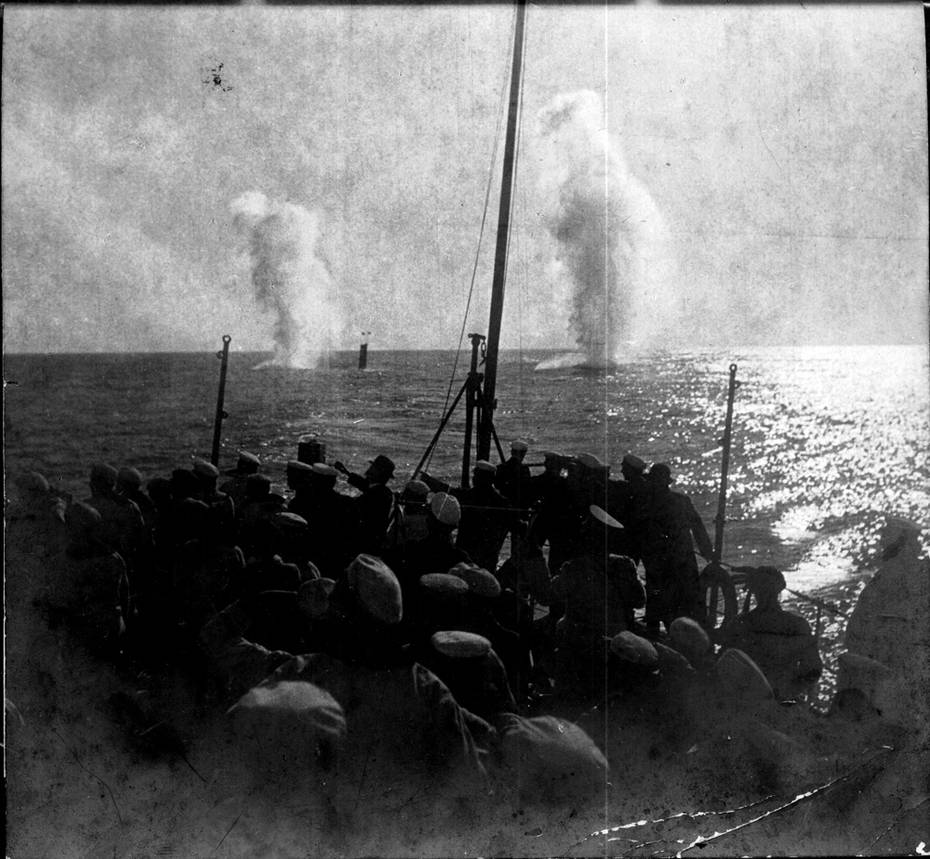
|
|
12×1 152mm/50 Modelo 1912 Bethlehem guns (not sure of the exact name currently)
http://www.navweaps.com/Weapons/WNUS_6-50_mk8.php
in US service, this is specifically the 6-inch/50 Mark 8 Mod 3
300 rounds per gun
The 6-inch secondary armament was placed in casemates, with six on either side of the ship. For protection, they were provided with 6 inches of armor.
and here’s a surprise! we now have a picture of one of those very guns!
Bethlehem Steel 6"/50 (15.2 cm) gun No. 577 Model 1912 used on Argentine Battleship Rivadavia. Mounting now on display at Museo Naval de la Nación, Buenos Aires, Argentina.
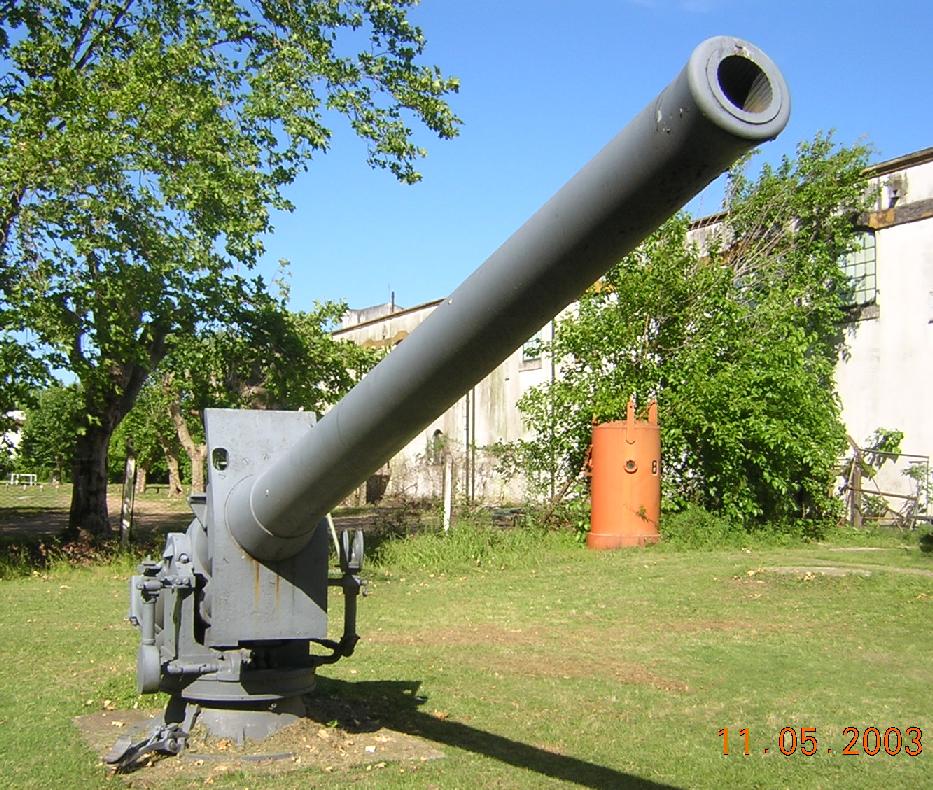
|
|
16×1 102mm/50 Bethlehem Marca 2
http://www.navweaps.com/Weapons/WNUS_4-50_mk9.php
same as 4-inch Mark 9 Mod 5s ingame on US starter Destroyers USS Litchfield and USS Barker, just produced by Bethlehem Steel
350 rounds per gun
The 4-inch anti-Destroyer armament was mounted unarmored in various places around the ship, including the main deck, superstructure, and far up near the bow.
|
|
2x1 533mm (21-inch) Modelo 1910 (name is apparently by their date of initial delivery) produced by Whitehead out of Fiume, Italy
like many battleships of the era, the Rivadavia-class had underwater broadside torpedo launchers, 1 per side, with 2 torpedo reloads per side plus one extra for a maximum ammo count of 7.
|
thanks to the book Naval Weapons of World War One by Norman Friedman, we now know what these are: Unique, and only used by Argentina, which would never use a “standard” torpedo design until into the Cold War era.
The Modelo 1910 torpedo was quite a robust beast for the pre-WWI period due to being powered by Whitehead’s brand new two-cylinder double-acting horizontal turbine engine that is probably what made this torpedo a good bit longer than some other 21-inch torpedoes- the Royal Navy’s 21-inch Mk I from 1914 was a whole two feet shorter by comparison, even with a greater payload weight.
|
this system also allowed for a reliable variable speed setting of:
41 knots for 2000 meters of travel
OR
29 knots for 5000 meters of travel
carrying a 150kg (330lb) guncotton warhead.
|
sadly, these Argentina-unique torpedoes came juuuuuust a little too soon to see the 1911 development of TNT being used in torpedoes.
|
|
|
(1930-1931)
as of early 1931: this area takes into account the series of the major 1924-1926 refits, through the series of minor equipment changes and improvements spanning from 1926-1931, specifically being the ships immediately prior to the 1928 seaplanes being removed in 1931.
Rivadavia and Moreno, returning to Argentina, immediately after completion of refits in 1926
4×2 305mm Marca L Modelo 1 guns, mounted in centerline & superfiring positions
2x2 305mm Marca L Modelo 1 guns, mounted en echelon in offset wing positions
when in Boston, Rivadavia and Moreno got quite the suite of upgrades for the main guns: they were fitted with a new fire-control system, rangefinders were added to the fore and aft superfiring turrets, the aft mast was replaced by a tripod; and to reduce exhaust interference when spotting ships in a battle, a funnel cap was installed.
all this increased the main armament’s effective range was increased from 13,120 yards (12,000 m) to 20,800 yards (19,000 m). and the turrets were modified to double the firing rate.
|
|
12×1 152mm/50 Modelo 1912 Bethlehem guns (AKA 6-inch/50 Mark 8 Mod. 3)
unchanged during refits
|
|
12×1 102mm/50 Bethlehem Marca 2
As originally built, there were sixteen 4-inch guns, but four of those were replaced with four 3-inch AA guns 40mm Odero-Terni cannons (that some sources mistake as 76mm) during the 1924–1926 modernization.
|
|
4x1 40mm/39 Odero-Terni Modelo 29
This is the exact same gun ingame as the 40mm/39 Vickers-Terni mod.1915/1917, Modif.1930 seen ingame on the Italian ships Leone, Tigre, Bartolomeo Colleoni, and Dardo.
this version however is from 1929, just months or even weeks before the merged companies of the Odero-Terni; originally the Cantieri navali Odero (Shipyard Odero), and armaments manufacturer Terni Steelworks (itself previously a joint venture with Vickers called Vickers-Terni); added the Cantiere navale fratelli Orlando (Orlando Brothers Shipyard) into their consortium in 1929, thus becoming the Società per la Costruzione di Navi, Macchine ed Artiglierie Odero-Terni-Orlando, commonly abbreviated as OTO
so i’ll leave it up to Gaijin as to which name they want to use. only the name is different.
|
|
4x1 47mm 3-Pounder Hotchkiss cannons QF 3-pounder Hotchkiss - Wikipedia without doubt this is the QF 3-pounder Hotchkiss.
Entirely ornamental and mostly just for saluting. Argentina even still uses this cannon, as seen in the below picture of the 3-pounders on the ARA Libertad, the Argentinian training ship in the modern day (the picture was uploaded in 2012 but it THINK it’s description says was actually taken in 2001)

sadly this addition done in 1914, probably soon after launch, maybe even just after first docking in Argentina, was for ceremonial purposes only- meaning its shells would only be blanks or fireworks.
|
|
2×1 533 mm submerged broadside torpedo tubes
additionally there was now a second torpedo type that the Argentinians seemingly uniquely had by the 1920s thanks to the E. W. Bliss Company licensing production from Whitehead and developing their own torpedoes:
Bliss-Leavitt 533mm Marca 2 Modelo 1-
it’s entirely possible this is actually an older relative of the early model American Mark 8s, as this Argentina-unique Marca 2 Modelo 1 has highly similar; though slightly worse; performance stats than the Mark 8 Mod.3A and Mod.3B
it’s also entirely possible that these were modifications of an old design as by this point they legitimately had a long range, but a speed that really only last generation “slow” battleships couldn’t simply just outrun.
These Marca 2 Modelo 1 torpedoes had a single speed setting of a more pedestrian 24 knots, but for an impressive 12 kilometer range, and carried a 170kg (374.8lb) warhead, certainly now being filled with TNT and not the obsolete Guncotton.
|
|
and now the biggest change (for War Thunder at least, it proved useless for the Argentinians), a launched Seaplane:
3x1 Fairey IIIF Mk.IIIM Seaplanes:
Later after the major refits, it was suggested to equip ships with seaplanes, for what in 1928 were 6 Fairey IIIFs bought (3 for Rivadavia, 3 for Moreno), however on battleships they for some reasons were never carried.
these were special model Fairey IIIF Mk.IIIM powered by 450 hp (336 kW) Lorraine Dietrich Ed12 engine in 1928.
They entered service in 1929, but likely were only aboard after some refits in 1930.
They had especially short services on the Rivadavia-class battleships, and the whole idea being phased out in 1931… probably because you can turn a battleship into only so much of a Swiss army knife.
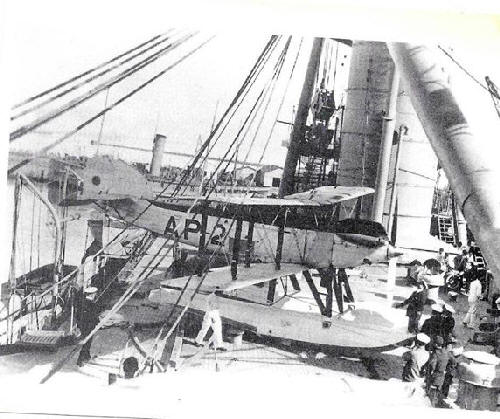
Fairey IIIF seaplane onboard ARA Rivadavia, 1931 (photo provided by Iván Dubaniewicz)
|
|
1937-1944:
https://web.archive.org/web/20090605023722/http://www.histarmar.com.ar/Armada Argentina/HistoriaAcorazadosArgentinos.htm, we have a major revision!
4×2 305mm Marca L Modelo 1 guns, mounted in centerline & superfiring positions
2x2 305mm Marca L Modelo 1 guns, mounted en echelon in offset wing positions
unchanged despite previous attempts to purchase German battleship armament, a fascinating little story-
the Argentinian government in 1929 looked to update the main guns for Rivadavia and Moreno, and turned to friendly Germany with proposals to either modify the guns to fire heavier shells and improve elevation angles, which went nowhere.
and then they turned to Plan B- the option tragically denied to us all. a full on Superdreadnought-caliber main gun replacement, that would’ve turned the Rivadavia-class from being suped up North Dakota-class dreadnoughts, into extra-beefed up USS Texas aficionado Superdreadnoughts, by swapping the 6 pairs of 12-inch guns for 6 pairs of 14-inch guns, presumably of a Krupp design.
Sadly the lack of budget space in the same timeframe as two modern cruisers and three submarines were being ordered from Italy, plus another two destroyers from Spain; meant that the main armament of the Moreno and the Rivadavia did not change. well f**k.
what confuses me is, why Weimar Republic-era Germany and not just the US again? this was literally the same time the USN Standard-Type battleships were being refit.
|
|
12×1 152mm/50 Modelo 1912 Bethlehem guns (AKA 6-inch/50 Mark 8 Mod. 3)
unchanged
|
|
no remaining 102mm/50 Bethlehem Marca 2
apparently by the 1940s, all of the old 4-inch guns had been removed, likely a testimony from the Departamento de Estudios Históricos Navales and/or Datos Estratégicos y Demás Información de los Buques de la Flota books
|
|
4x1 47mm 3-Pounder Hotchkiss cannons
unchanged, still ceremonial, still want one for my living room, still want another for dealing with annoying customers at my register.
|
|
4x1 40mm/39 Odero-Terni Modelo 29
unchanged
|
|
1 to 7 Machine Guns - COLDOWN clarifies that these were light machine guns. Madsen LMGs in 7.65mm Mauser at that…
and thankfully not poorly documented 20mm cannons of potentially slightly time traveling origin.
so clearly the Rivadavia and Moreno got some extra firepower for… well i’d say landing parties or boarding actions but let’s be honest it’s in case of full blown mutiny where the only loyalists are the ones holding the Madsens that the South American nations in general had a weird fondness for for way longer than the guns were as not-totally obsolete LMGs.
SOURCES:
SPECIAL:
Departamento de Estudios Históricos Navales (Department of Naval Historical Studies) - firsthand source, available only on site
Datos Estratégicos y Demás Información de los Buques de la Flota (Strategic Data and Other Information on the Ships of the Fleet) - firsthand source, available only on site
both of these are firsthand sources on ARA Rivadavia and ARA Moreno authored by the Argentine Ministerio de Marina circa the 1950s, both are books likely only available on site so uhhh… ¡Diviértete en Argentina!
online:
http://www.navypedia.org/ships/argentina/arg_bb_rivadavia.htm
(some of these cover ARA Moreno but there’s no serious difference between the two)
http://www.histarmar.com.ar/Armada Argentina/Buques1900a1970/AcARARivadavia-Historia.htm
http://www.histarmar.com.ar/Armada Argentina/Buques1900a1970/AcARARivadavia-Moreno-Modelos.htm
literary:
Naval Weapons of World War One, by Norman Friedman (PDF page 1069 or 1147, section II/10 “OTHER NAVIES TOREDOES”)
Burzaco, Ricardo and Patricio Ortíz. Acorazados y Cruceros de la Armada Argentina, 1881–1982. Buenos Aires: Eugenio B. Ediciones, 1997. ISBN 987-96764-0-8. OCLC 39297360.
Whitley, M.J. Battleships of World War Two: An International Encyclopedia. Annapolis, Maryland, United States: Naval Institute Press, 1998. ISBN 1-55750-184-X. OCLC 40834665.
Scheina, Robert L. Latin America: A Naval History 1810–1987. Annapolis: Naval Institute Press, 1987. ISBN 0-87021-295-8. OCLC 15696006.
various Jane’s Fighting Ships profiles, from 1902, 1910, 1920, possibly 1925, and likely elsewhere
Conway’s All the World’s Fighting Ships: 1906–1921 PDF/djvu page 411
Arguindeguy, Pablo - Notes on the Ships of the Argentine Navy.
Burzio, Humberto - National Navy. Historical Review of its Origin and Organic Development. 1.810-1.960.
Destéfani, Laurio - Argentine Maritime History.

